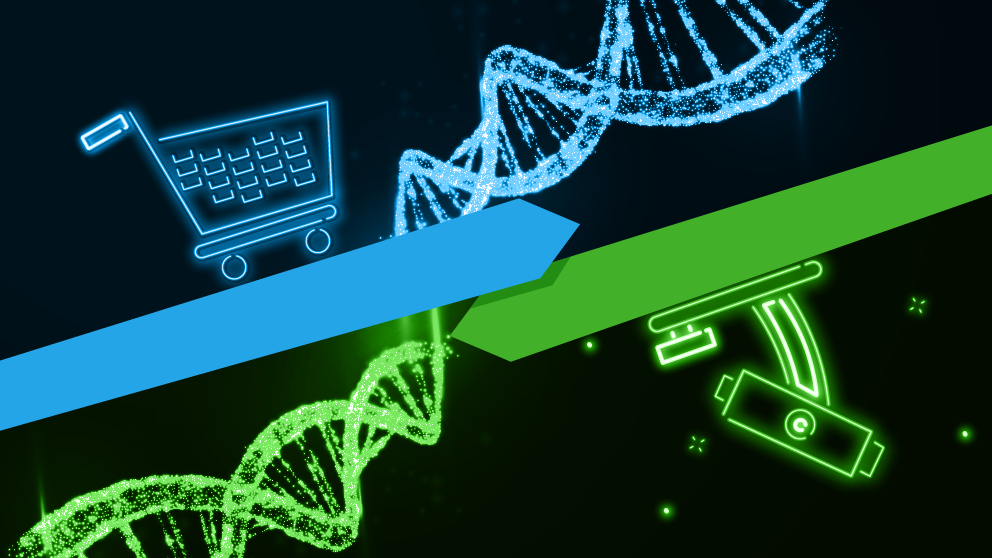Working with Humanized NSG mice: In-sourced or Out-sourced

The term “humanized” mouse can mean many things to many people. Here, we’ll define humanized mice as a mouse that harbors engrafted human tissue or cells, such as immune cells. Whether you choose to humanize mice yourself or obtain them already humanized, here are some helpful tips and potential pitfalls to avoid:
- Using the right number of cells
As mentioned, mice can be engrafted with human tissue or cells, such as CD34+ hematopoietic stem cells (HSCs) or peripheral blood mononuclear cells (PBMCs) from human donors. There is an optimal number of cells to use: too many CD34+ HSCs can lead to anemia, while too many PBMCs can accelerate graft versus host disease (GvHD). Too few cells can lead to low or no engraftment.
At JAX, our scientists have run multiple studies to optimize the number of cells to use per mouse, which allows you to generate larger cohorts of humanized mice from a single donor, maximizing the health of the cohorts.
- Moving too quickly or too slowly
Once you have engrafted your cells, the mice won’t be ready to use there and then, or even overnight. For example, in CD34+ Hu-NSG mice, it takes 12-15 weeks for the T cells to develop and mature. In this model, hematopoietic engraftment is established and confirmed first, then the tumor of choice is engrafted second. Studies are begun once tumor growth is confirmed, and a rolling enrollment is used based on when tumors reach a specified size.
In the case of humanized PBMC mice, waiting too long to start may result in the mice being too sickly even before you begin your study. For example, many researchers are interested in using these mice to co-engraft patient-derived xenograft (PDX) tumors to examine T cell-mediated tumor responses. However, waiting for the PDX to grow to the appropriate size to begin the study may take several months, and by then, the mouse may have succumbed to GvHD (depending on which NSG variant is being used). Therefore, the best approach is to engraft the PDX first, then inject the PBMCs.
JAX Onco-Hu® models are the perfect compromise: CD34+ Hu-NSG humanized mice co-engrafted with PDX tumors that are available for shipment worldwide.
- Ensuring pathogen-free status
If you’re planning to engraft either HSCs or PBMCs yourself, it’s imperative to confirm that your donor cells are pathogen-free, in addition to confirming the health of the recipient mice. Otherwise, because NSG mice are severely immunodeficient, they will succumb to the organisms present in the tissues you’ll engraft. At JAX, we routinely test all cells for a variety of pathogens, including:
- Human immunodeficiency virus (HIV),
- Hepatitis B virus (HBV),
- Hepatitis C virus (HCV)
Only those materials with negative results are used in any humanized mouse that JAX develops for in-house studies or to ship to facilities around the world.
Of note, JAX also tests human patient-derived xenograft tumors (PDX) and related materials for LCMV and general microbiological culture. These materials must be negative before they are used in any study or engraftment of mice.
- Leveraging a Correct Study Design
There are many factors to consider when designing a preclinical study, including: - Finding the most appropriate model to use, or host background to engraft with humanized cells (for some additional tips designing studies, check out this blog)
- The number of cells to engraft per mouse
- The number of cells that can be derived from a single donor
- The number of mice needed per condition, or study arm- based on the number of mice that can be obtained from that donor
- The number of arms required for statistical power and to draw a logical conclusion
-
Ensure your mice are ready for engraftment
Human cell or tissue engraftment may require the recipient model to be irradiated. The irradiation helps to ensure that the mouse will receive the donor cell, and if the engraftment is done correctly, it will enable the donor cells to develop.
Humanized mice from JAX have been properly irradiated and engrafted to make sure that your models are consistent and your data reproducible. As JAX has developed the NSG™ model, the most published immunodeficient mouse, in addition to its variants, we are confident in our scientific expertise to produce the very best models for your research needs.
At JAX, we not only can we provide engraftment services, but also we can execute your studies. Our study directors have optimized protocols resulting in more mice per donor and leading to more consistent data. Furthermore, when you’re planning your studies, we are more than happy to share our expertise with you.
Once you’ve determined the most appropriate humanized model to use for your study, the biggest question you can ask yourself is: do you want to spend your time optimizing the model or using it to advance your research? At JAX, we have the scientific expertise and know-how to address many of the challenges researchers face in optimizing and utilizing these models, and overcome them with reproducible models, engrafted with pathogen-free CD34+ or PBMCs, in combination with robust studies to get you accurate data to make better-informed decisions for your research. Visit the JAX humanized mouse page to learn more about the latest cutting-edge models and services from JAX.
Recommended Resources
JAX humanized mouse page
Blog: Top Tips on Selecting the “Best” Immunodeficient Mouse Model for Your Research
Blog: Why humanized mice?
Webinar: Humanized Mouse Models: Applications in Oncology & Infectious Disease
Blog: CD34+ Hematopoietic Stem Cell Humanized Mice: The Basics
JAX Online Trailblazing- Oncology page